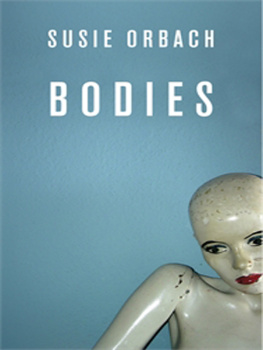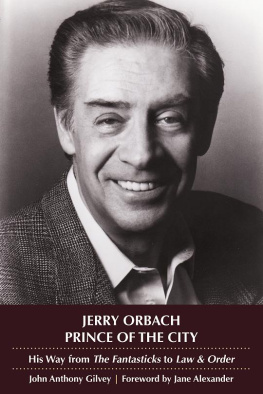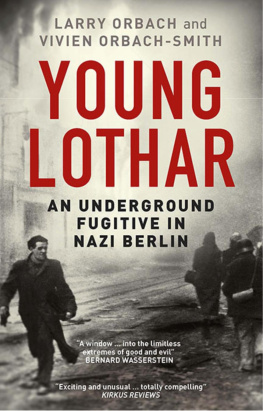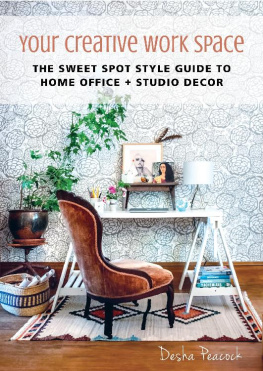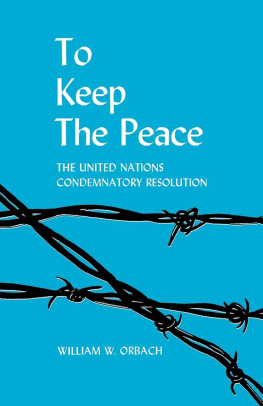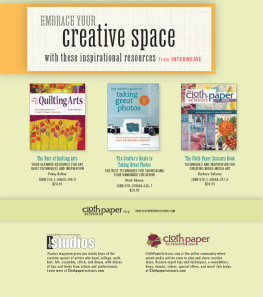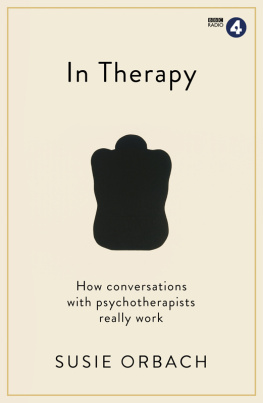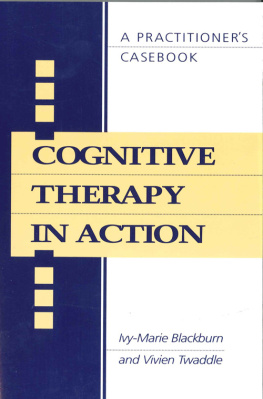Orbach - The Good Enough Studio: Art Therapy Through the Prism of Space, Matter, and Action
Here you can read online Orbach - The Good Enough Studio: Art Therapy Through the Prism of Space, Matter, and Action full text of the book (entire story) in english for free. Download pdf and epub, get meaning, cover and reviews about this ebook. year: 2020, genre: Children. Description of the work, (preface) as well as reviews are available. Best literature library LitArk.com created for fans of good reading and offers a wide selection of genres:
Romance novel
Science fiction
Adventure
Detective
Science
History
Home and family
Prose
Art
Politics
Computer
Non-fiction
Religion
Business
Children
Humor
Choose a favorite category and find really read worthwhile books. Enjoy immersion in the world of imagination, feel the emotions of the characters or learn something new for yourself, make an fascinating discovery.

The Good Enough Studio: Art Therapy Through the Prism of Space, Matter, and Action: summary, description and annotation
We offer to read an annotation, description, summary or preface (depends on what the author of the book "The Good Enough Studio: Art Therapy Through the Prism of Space, Matter, and Action" wrote himself). If you haven't found the necessary information about the book — write in the comments, we will try to find it.
Orbach: author's other books
Who wrote The Good Enough Studio: Art Therapy Through the Prism of Space, Matter, and Action? Find out the surname, the name of the author of the book and a list of all author's works by series.
The Good Enough Studio: Art Therapy Through the Prism of Space, Matter, and Action — read online for free the complete book (whole text) full work
Below is the text of the book, divided by pages. System saving the place of the last page read, allows you to conveniently read the book "The Good Enough Studio: Art Therapy Through the Prism of Space, Matter, and Action" online for free, without having to search again every time where you left off. Put a bookmark, and you can go to the page where you finished reading at any time.
Font size:
Interval:
Bookmark:
The Good Enough Studio
Art Therapy Through the Prism of Space, Matter, and Action
Nona Orbach
Producer & International Distributor
eBookPro Publishing
www.ebook-pro.com
The Good Enough Studio
Nona Orbach
Copyright 2020 Nona Orbach
All rights reserved; No parts of this book may be reproduced or transmitted in any form or by any means, electronic or mechanical, including photocopying, recording, taping, or by any information retrieval system, without the permission, in writing, of the author.
Contact:
This book is dedicated to my grandchildren:
Omer, Ayala, Noam, Michael, Hillel
I would like to thank all who have contributed to my writing and accompanied it with love, patience, and much goodwill.
I would like to thank my clients, who have taught me how much creation can change ones life path. It was a privilege and an enriching learning experience to join the journey of each and every one of you.
I would also like to thank the dedicated readers who have enlightened me:
Dr. Ofra Eyalon, who provided a generous ear, wisdom, and humor, helped me differentiate between main ideas and supporting details and encouraged me to offer my knowledge to the world, even if I am unsure that it is perfect.
Maayan Schneider for her assistance in the process of writing in a language that is not my mother tongue. Her thorough reading and deep questions made this book more accurate.
Michaela Mende Janco who commented on art therapy as well as linguistic accuracy.
Yaron Mazliach who listened carefully and taught me about Bion.
Judy Pinko, Yael Guilat, and Orit Yacobson for their encouragement, support, and listening.
My young colleagues, whose comments and questions always lead me to write more. This book was written for their generation.
All of my students and the Studio Visits online learning community, whose questions served as catalysts for this writing project.
My teachers and colleagues, whether or not we know each other personally, whether or not they are of my generation: Loris Malaguzzi, Carla Rinaldi, Vea Vecchi and all the originators of the Reggio Emilia approach, who brought into the world a humanistic, democratic model which has been enriching us for decades.
My editor Amy Thomas, who understood the text from within from the very beginning. Her love for and knowledge of the English language and poetry bridged between the physical aspects of the studio and the world of the text.
From the bottom of my heart, Suzanne Axelsson, Lilach Galkin, Malka Haas, Catherine Hyland Moon, Victor Lowenfeld, Peter London, Roberta Pucci, Rhoda Kellogg, Norio Saki, Arie Rotman, Yoni Shor, and Lenore Steinhardt.
My partner Eylon, our daughters Naama and Talya and their partners, my family and young grandchildren, who are a source of joy to me and a daily reminder that we are all made in His image.
Note: All details of clients were changed and when needed, permission was given for this publication.
A
rt therapy, as a practice, is considered a young one in the family tree of psychology, where it forms one branch among the helping professions. But we art therapists are the offspring of the first men and women who told stories, danced, and sang around the fire, those who powdered plants, stones, bones, and charcoal and left images and engravings on cave walls. Our common archaic roots are the arts.
I have written this book from the perspective of an artist, educator, and therapist working within the context of a studio setting as an extension of ourselves. Such a setting is a safe place where permission, empathy, and encouragement foster intuitive choices and allow reverie and being to unfold. For art therapists, art educators, and kindergarten teachers who wish to create such a studio environment, this book is for you.
These pages explore our archaic artistic roots as we interpret actions and mediums into pedagogical and emotional understanding. Within this archaic, cultural-evolutionary context, I bring stories from the studio with a focus on art materials and processes of their use. These stories describe and define an action-matter view of art therapy, one that foregrounds materials and the actions done with them.
I will highlight the profound connections between the different choices of materials and the physical acts of the artists body as manifestations of a metaphorical, alchemical process the soul goes through. We will see time and again how the body somehow identifies its required path and transforms materials into the deep inner truth of the creator. We will perceive how the choreography and reciprocity of art-making has a precise metaphoric and poetic truth in our life that, when permitted to be, and when recognized, can be freeing and help us to flourish.
Art therapy processes have surprising synchronicities and reveal the emotional accuracy and overlapping of metaphorical meanings of choices on the path to integration and healing. This book will explore many examples of these.
In my description of the art therapy concepts and processes that form my practice, I also try to illuminate the integration between different areas of knowledge, such as cognitive development, nonverbal body signals, culture, art history, artistic technical experience and knowledge, and psychology. Such languages cultivate the art therapist as she joins her clients in authenticity, liveliness, transformation, and health.
The book might also enable one who is not familiar with studio life to experience something of it. This is why I have used different writing genres: essay, technical text, tables, chronological art process, stories. I have also included some images. This variety hints at and symbolizes the richness of languages of the studio.
I have written about the processes and experiences of the studio as accurately and deeply as possible, but toward the end of the writing process, there was an unplanned shift. On a long night flight to Kyoto, I comprehended the studio as an idea, and not as a physical space at all! This insight opened a window onto a new way of thinking about the studio. Thus, the last chapter is a collection of stories that demonstrate the studio as an idea, as a state of mind.
While writing, I have reflected on the next generation of therapists, such as my supervisee, who sense that materials have a language of their own, and wish to develop their understanding of psychology, brain research, technology, and other frontiers of knowledge and of how to nurture, integrate, and refine our unique archaic knowledge from the caves with new knowledge, to the benefit of our society.
You are invited on a journey that might influence your studio and perhaps even your practice. I hope this book will encourage you to explore our archaic roots as they connect to our lives today, as such connections are sure to shape our profession in the future.
For our house is our corner of the world. As has often been said, it is our first universe, a real cosmos in every sense of the word. If we look at it intimately, the humblest dwelling has beauty.
Gaston Bachelard
W hen you enter the studios stimulating environment, you notice stained paint jars, brushes of all sizes, pencils, colored pastel boxes, and many kinds of paper your fingers wish to caress. You might smell turpentine or linseed oil, or hear running water as hands smeared with clay are being rinsed.
You might notice people are working: one is painting, another sculpting, perhaps someone is weaving. A few are watching a screen and intensively discussing an animation piece they are working on. They might give you a short glance, but most of them seem so absorbed, they do not notice there is a guest.
Font size:
Interval:
Bookmark:
Similar books «The Good Enough Studio: Art Therapy Through the Prism of Space, Matter, and Action»
Look at similar books to The Good Enough Studio: Art Therapy Through the Prism of Space, Matter, and Action. We have selected literature similar in name and meaning in the hope of providing readers with more options to find new, interesting, not yet read works.
Discussion, reviews of the book The Good Enough Studio: Art Therapy Through the Prism of Space, Matter, and Action and just readers' own opinions. Leave your comments, write what you think about the work, its meaning or the main characters. Specify what exactly you liked and what you didn't like, and why you think so.

